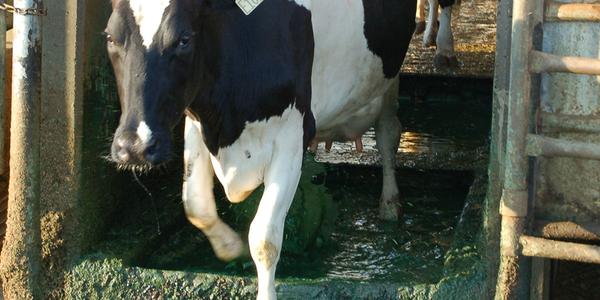The farm staff at Barony make use of the CowAlert automated system from IceRobotics Ltd. This technology consists of a leg mounted sensor which tracks activity for fertility management but also gives information on lying time, lameness probability and a daily mobility score for every cow.
The system can pick up cows that are starting to walk differently or lie down more, providing an alert to a potential problem. For example, a cow is marked as red if she has a high probability of being lame. Orange marked cows are potentially lame or are likely to become lame, alerting the farmer and enabling early intervention.
A key member of the team at Barony is Veterinary Technician Davie Aitken from Ark Vet Practice in Lockerbie, who is ROMS accredited (ROMS – Register of Mobility Scorers).
Davie visits the Barony herd to mobility score the cows every six weeks, with these scores required to be submitted to Arla quarterly as part of the farms milk contract. Cows are scored on the AHDB mobility scoring system on a scale of 0 to 3 where cows with scores 0 and 1 are classed as having good mobility and are not lame.
A score 2 cow is lame, with uneven weight bearing on a limb that is easily identifiable. This cow would benefit from foot inspection and treatment as soon as possible to prevent her from becoming a score 3 cow. A score 3 cow is very obviously lame and unable to keep up with the herd and has a high probability of being culled.

While the main causes of lameness, claw horn lesions and skin diseases, are present to varying degrees throughout the herd, it was the skin disease digital dermatitis (DD) that was the main issue last autumn.
In order to tackle the high number of cases, the herd underwent a blitz treatment as recommended by SRUC vet Colin Mason. This is where every cow had their feet inspected in order to identify all the DD lesions present. These lesions were treated with a topical antibiotic spray daily for three days, during which foot bathing did not occur. Once the third treatment had been carried out, on the fourth day cows were foot bathed once a day with copper sulphate and this has continued on a daily basis since.
The foot bath at the farm is a permanent concrete bath which is four metres in length. As this is a permanent fixture, the cows are used to walking through the foot bath on their return from the parlour to the cubicles and the benefit of the 4m length is that it allows several dunks of the feet for maximum efficacy of the treatment solution.
The farm employs a foot trimmer (Ryan Adamson from RC Adamson Ltd) to carry out routine trimming of all cows at drying off and around 100 days into lactation. This ensures that the cow goes into the dry period with a good foot shape, and any DD lesions can be picked up, which otherwise could go unnoticed in the dry period, increasing the severity and spread of the disease when cows are less likely to be regularly foot bathed.
Claw horn lesions such as sole ulcers and white line disease most likely tend to occur between 70-120 days after calving, so an inspection and routine trim at this time will pick up any problems early, allowing them to be dealt with before significantly impacting on cow health and production.
All cows that are inspected have their details and any issues with their feet recorded, which is then passed onto the farm team for any treatments required or just alerts them to cows that might need a close eye kept on them.
While the cost of a foot-trimmer is an added expense, the farm staff see it as money well spent and prevention is better than cure when taking into account vet bills for treatment, lost milk and poorer fertility. You can hear more about lameness management at SRUC’s Barony dairy herd on episode 29 of FAS TV: https://www.fas.scot/fas-tv/
